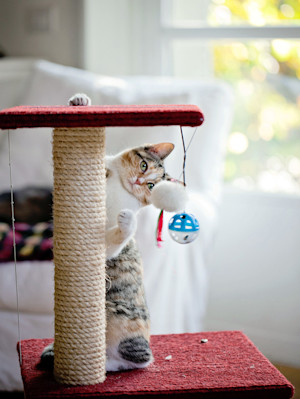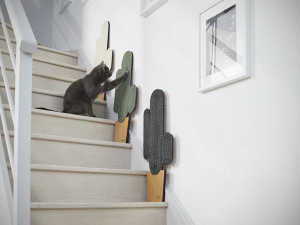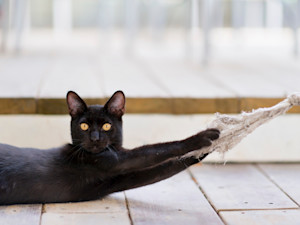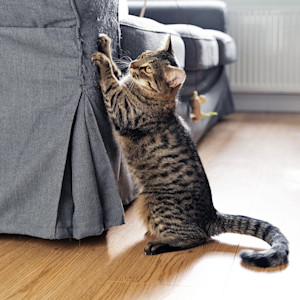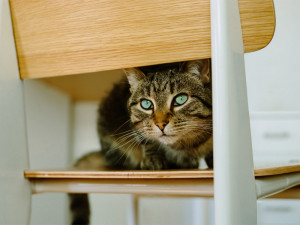How to Stop Cats From Scratching Furniture
Don’t they care that you saved for six months for that sofa?
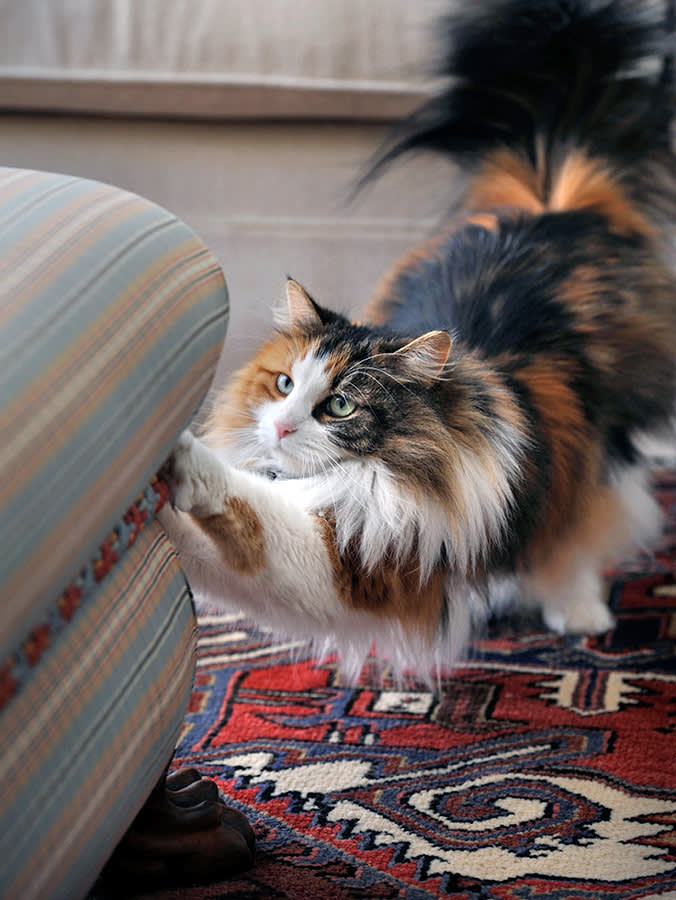
Share Article
In This Article:
Why Do Cats Need To Scratch? Provide Your Cat With a Scratching Post Make Your Furniture Less Attractive To Your Cat Care for Your Cat’s Nails
This is one of the universal frustrations about having a cat. Why must they scratch up our furniture? Don’t they realize we scrimped and saved to buy that couch, and we’d like to avoid it looking like a giant pile of shredded fabric and string?
Your cat probably loves to scratch furniture. You’d probably love it if they didn’t. While you can’t remove their need to scratch, there are things you can do to discourage scratching the furniture and encourage your furry family member to use their designated scratchers instead.
Why do cats need to scratch?
While there are many reasons that cats need to scratch, there’s one overarching motivation — instinct! Scratching is an instinctual need that can’t be removed. It’s essential to understand this as you consider how to prevent your cat from scratching furniture and other unwanted items.

We have a great article that provides more detailed information on the reasons behind scratching furniture. I highly recommend that you give it a read. It will help inform your “stop scratching” plan.
Here are a few highlights:
Claw health
Cats will scratch as a way of maintaining their nails. When the nails become too long, they can cause physical discomfort for your cat, altering the paw position as they move along the floor and even making it harder to stabilize on slick surfaces.
Scent-marking
Cats scratch as a way of depositing scent. It’s a form of communication with other cats, used to mark territory and share information.
Cats also scratch to be surrounded by their scent, which is comforting during times of stress.
Play
Scratching is often incorporated into play and other happy activities. Your cat may interrupt a play or petting session for a quick scratch. A case of the zoomies may include a round of scratching before taking off again.
Stretching
Cats love to stretch, especially after a nap. It’s common for that stretch to include some scratching. Many cats prefer a tall, sturdy scratching option, like the back of your sofa, so they can reach really high and put a lot of weight into that stretch-n-scratch.
Provide your cat with a scratching post.
We discussed the idea that scratching is a way of fulfilling an instinctual need. To encourage your cat to scratch something other than your furniture, the alternative has to meet those same needs just as well, if not better. That starts with choosing the right scratcher.
Pick the right type of scratcher for your cat.
Think about the possible reasons your cat prefers scratching a particular piece of furniture. These are clues to the type of scratcher that will best meet their needs. Consider:
Orientation: Do they scratch horizontally, vertically, or at an angle?
Material: Is the furniture fabric, wicker, wood, etc.?
Weight: Is the furniture heavy and stable, even with all your cat’s weight pulling on it?
Now, what type of scratcher might fit the bill? It’s not just cat trees and little scratching posts these days. You can find all kinds of scratching options, like:
Mats: These are usually made of sisal and can be attached to the wallopens in new tab. Some even come with twist pins, allowing you to attach them directly to furniture. But be careful with that option. If the pins come out, you’ve got a dangerous “toy” your cat may bat around or pick up with their mouth. They could also damage furniture if your cat uses a lot of force when scratching. I prefer mounting them on the wall. This is great for cats who like a solid vertical-scratching option.
Horizontal, angled, and L-shaped scratchers: These are generally made from carpet, sisal, or cardboard. Some are substantial, weighty pieces that won’t move when your cat scratches. Others are very simple and light. But they still work well if your cat sits on one end and scratches the other. I love the L-shaped option to protect the sides of furniture. You can set the scratcher right against the furniture, and the L shape keeps it upright.
Scratcher furniture: Depending on your needs and budget, you can find side tables and other furniture pieces (both for people and cats) with scratchers built right in.
Do a little research, keeping your cat’s preferences and your aesthetic and space needs in mind. You may need to try a few options to see what they respond to.
Place the scratcher near the furniture being scratched.
Your cat is telling you where they need to scratch. So, start there, with your new scratcher as close as possible to the spots your cat is currently scratching on the furniture. Once they’re using the scratcher regularly, you can try slowly moving it to a better location for you (if needed) and see if they continue using it.
Encourage your cat to use the scratcher.
Give your cat a reason to choose the scratcher instead of the furniture. Remember, both options meet the same needs. Why should they choose one over the other? Because using the scratcher means they get really good stuff!
Any time your cat scratches the new scratchers, throw a party — verbal praise, pets, treats, play, whatever they love. Even sniffing the scratcher gets a positive reaction. You can even sprinkle catnip on the scratcher to attract your cat to it.
If they scratch the furniture, don’t get upset. Just calmly interrupt them. Pick them up and set them right back down (if they’re comfortable being handled) or call them away using a very neutral tone.
Now you can redirect them to the appropriate scratcher. Call them over, lure them with treats or toys, make a big deal out of it. Remember, the goal is to give them a reason to pick the scratcher over the furniture. Scratching the furniture means nothing happens. They just get interrupted. Scratching the scratcher means they get so much good stuff.
Double-check that it’s sturdy.
This may seem like an odd thing to point out. But so many scratching posts are tiny, light things that wobble and fall over with the first good scratch.
Cats often choose furniture, in part, because it’s so sturdy. Your lounge chair isn’t going anywhere, no matter how hard they scratch. You need scratcher options that are just as sturdy.
Make your furniture less attractive to your cat.
Another way to encourage your cat to choose the new scratchers over the furniture is to make the furniture less appealing as a scratching option. These are temporary measures until your cat is reliably using the new scratchers.
Here are some things you can try (and a few I tend to avoid):
Place double-sided sticky tape.
We’re talking about tape specifically designed for cats, not the double-sided tape found at the hardware store. Stick it over the scratching spots on your furniture. The outside is also sticky. If they scratch the tape, it won’t hurt them. But it also won’t be particularly appealing. Because you’ve placed a great new option nearby, they’ll hopefully switch right over to that one.
Cover with a cat furniture protector.
You can buy furniture protectors. You can also drape a blanket over the area or wrap some aluminum foil around it. Same idea as the tape. You want to make it less appealing so they’ll have a reason to avoid that area.
Use an anti-scratch spray for cats.
This is one I don’t love. These sprays usually include ingredients that cats find unpleasant. They may smell bad, which can increase stress.
You can’t keep an unpleasant smell just to that spot. It will move around the room, making your cat uncomfortable in the entire space.
What do animals do when there’s an unpleasant smell around? They cover it up with their scent. Your cat may end up scratching more, or worse yet, peeing or spraying, to get rid of that stressful smell.
Spray a pet-safe odor neutralizer
This is another one I’d caution against. If your cat is scratching to deposit their scent, and you use a spray to remove that scent, the natural thing for your cat to do is scratch more to put that scent back. Instead, offer alternative ways for them to leave their scent in the area, such as scratcher options, wall-mounted groomers that encourage rubbing, or catnip sprinkled on the floor, which also encourages rubbing.
Continue redirecting them to appropriate items.
This isn’t an instant fix. You’re training your cat and trying to break a habit. Both of those take time and patience. So, hang in there.
Even when your cat is using the scratchers regularly and stops using the furniture, continue to offer positive reinforcement. As I write this article, I look up to see my cat using his favorite scratching post. While he’s not in training right now, it was still an opportunity for me to reinforce the idea that good things happen when he uses that scratcher. Make it part of your cat's routine to reward the behaviors you want to see more of.
Care for your cat’s nails.
Nail care is just one reason your cat may scratch furniture. But it’s important. Some cat claws grow thick enough that they can actually cut into the paw pad. Very long nails can curve and grow into the pad. It’s also hard for your cat to balance when their nails are too long. That can be really rough for senior cats who may have arthritis or limited mobility.
If your cat has any of these issues, they may rely on scratching furniture and other surfaces to manage their nails. That’s why proper nail care is important. Your veterinarian can show you how to gently and safely trim your cat’s nails.
Bottom line
Cats scratch furniture because they’re trying to meet many important needs, from nail care to communication.
You can provide alternative scratching options that meet those needs even better.
Be sure to take your cat’s preferences into account when choosing scratching posts, mats, and other options.
Make your furniture less attractive for scratching and place the new scratchers nearby.
Reward your cat when they show interest in those new scratchers to encourage continued use.

LeeAnna Buis, CFTBS, FFCP
LeeAnna Buis has adored cats her entire life and thought she knew them inside out and sideways. But it wasn’t until she worked with a feline behavior consultant that she fully understood how incredible, complicated, and inspiring they really are. She made a career change, starting the certification process to become a behavior consultant right away. She discovered what unique, fascinating, complex creatures cats are and knew this was what she wanted to do with her life — help others on a similar journey to truly knowing, loving, and appreciating their cats.
LeeAnna earned her certification through Animal Behavior Institute, where she received the certified feline training and behavior specialist (CFTBS) designation.
Related articles
![Cat playing with scratching post.]()
How to Train and Get Your Cat to Use a Scratching Post
You can stop your cat from scratching everything in sight.
![Grey cat sitting on on stairs scratching at the cactus shaped Meyou Paris Vegas Scratcher]()
The Best Cat Scratching Posts, Pads and Everything in Between
Your cat’s claws are out. Do you have scratchers at the ready?
![A black cat holding onto a rope with its claws.]()
It’s Seriously Uncool to Declaw Your Cat
A cat veterinarian explains why the inhumane surgery is no joke.
![Cat scratching a couch in the living room.]()
Having This In Your Home Will Make Your Cat Scratch More, New Study Says
Plus, how to keep your kitty from destroying the couch.
![Cat sitting on a kitchen chair, looking at the camera]()
How to Cat-Proof Your House
Ten steps for keeping your cat out of trouble.
![A woman and her cat plays with the Vetreska heartpurrple cat climber.]()
The Best Toys for Kittens in 2025
They love to play, and you need to keep them busy. Here you go.

